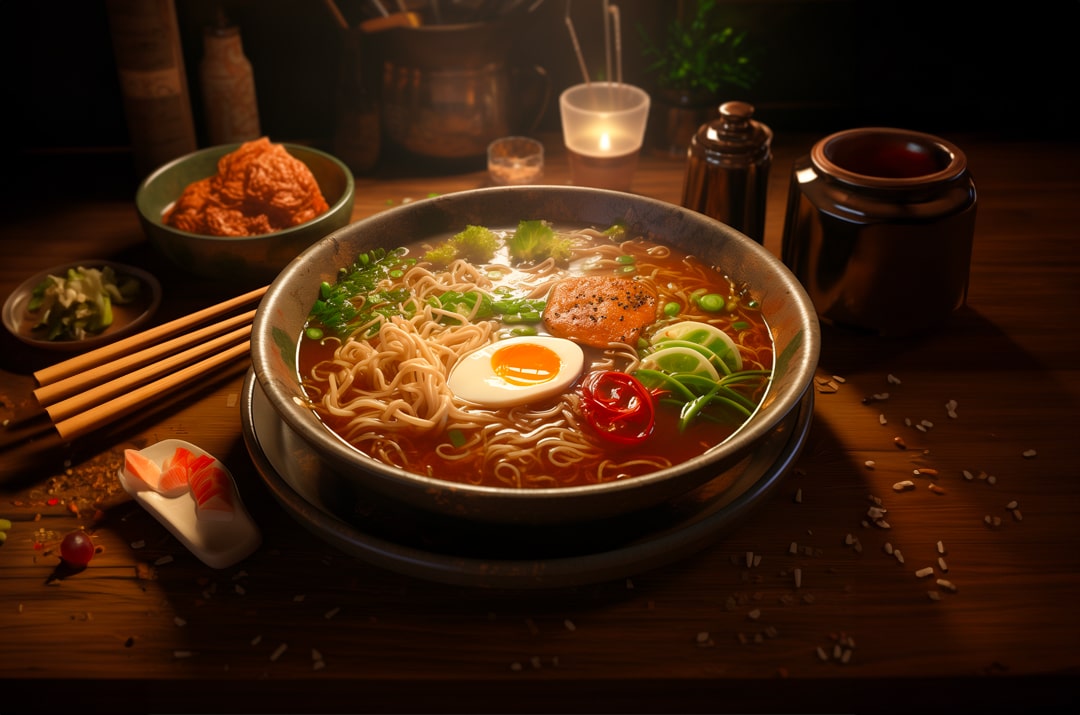Ramen Soup: All You Need to Know About Asian Classic Fast Food Meal

What can be more heartwarming on a cold day than a bowl of hot, spicy, saturated flavors and tastes broth with noodles and vegetables? Of course, this meal when some proteins accompany it! The result is what we today call ramen soup, a real iconic Japanese dish which crossed the ocean to become eternal value among gourmets, restaurant critics, and people who love tasty food.
Yet, what do you know about ramen soup except it consists of noodles and broth? There are lots of interesting facts we are going to share with you about it!
The History of Ramen: What Is It And Where It Came From
Ramen soup is not of Japanese origin. That’s the first mind-cracking fact you should know about it. Since the XVIII century, it was predominantly the dish of poor Chinese peasants and its cooking tradition was based on the principle: take all you get in your home, put it into the pot, cook it in broth and add some noodles to improve its nutritional value. Even the name ramen is derived from the Chinese word “lamian” which means stretching noodles. In Japanese, there is no sound L, thus, the name is transferred into “ramen”.
There are two basic legends about where ramen soup came from.
- One of them says that at the beginning of the XX century, in Yokohama Chinatown, noodle soup with veggies and meat became extremely popular, especially during post-war food shortages.
- The second legend says that the Japanese military brought it after WWII from China.
Be it as is, a real breakthrough for ramen soup occurred in the 60s when Momofuku Ando invented instant noodles, and the world of fast food was revolutionized.
Since that time, ramen soup has become a real must-try all over the world. It is extremely popular in Japanese bistros, it is served in high-class Asian restaurants, and it strongly took its place in kitchens and hearts of home cooks.
Classic Recipe and Modern Variations of Ramen Soup
What is classic ramen soup? Even in its initial form, it has multiple variations. The base for this meal includes rich-flavored broth (typically, pork), wheat noodles, and additional components which are meat slices, boiled eggs, algae of various types, miso, mushrooms, menma, scallions, and soy. Local classic variations include:
- Miso broth ramen soup from Sapporo.
- Kitakata region offers ramen soup with the broth of pork and small dried fish niboshi.
- Yokohama’s lekei ramen with thick noodles, soy sauce and pork broth with pork marrows.
- Tokyo's ramen with chicken broth.
The recipe for ramen soup is quite simple. You need to make a rich and intense broth of fish, meat, chicken, or miso. Then you Have to serve the dish in a bowl. Place some boiled noodles (if you use instant noodles, you can skip this stage).
Add proteins and veggies. Add sauces and additional tastes. Then pour a couple of ladles of boiling broth into the bowl. Typically, ramen soup needs to be consumed right after serving to keep the broth hot.
What can be added to ramen soup besides the broth and noodles?
- Various proteins like pork meat, pork bones, chicken, tuna, or turkey.
- Dried fish (katsuobushi tuna flakes or niboshi dried sardines).
- Miso.
- Leeks.
- Shiitake mushrooms.
- Nori or wakame seaweed.
- Bamboo sprouts.
- Edamame beans.
- Soy sprouts.
- Soy sauce.
- Boiled eggs.
- Chili peppers.
Besides, in deluxe restaurants, chefs create author’s ramen soup recipes and often include rare ingredients in them i.e., truffles, caviar, and slices of Beijing duck.
Ramen Soup in Facts and Numbers
Now let’s focus on figures and facts. You have already understood that ramen soup is nutritious, rich in tastes and flavors, and a healthy dish. Let’s learn about it in detail.
- Ramen soup even has its emoji created in 2010.
- In Yokohama, the only museum devoted to ramen soup is situated. It is called the Shin-Yokohama Ramen Museum.
- Due to Tasteatlas, ramen soup possesses the #4 place among the best-rated Japanese soups. #8 place as the best-rated noodle dish in the world, and #11 place as the best-rated soup in the world.
- A portion of ramen soup provides you with 10% of proteins, 1.1% of fats, and 69.1% of carbs. Its energy value is 337 calories per 100 g. Yet it depends much on the density of broth and the components of the meal.
As a meal, ramen soup is very useful and suits even everyday consumption. You can add it to your menu for the following reasons.
- Each type of ramen soup is good for digestion due to its balanced recipe and lots of liquid in the dish.
- The broth for ramen soup usually is made using slow-cooking principles to get as much taste and collagen from meat. Thus, it becomes a great source of proteins and collagen.
- Various veggies and soy products in ramen soup provide you with vitamins and microelements.
And it is nutritious but not heavy for your digestion, providing you with 337 calories per 100 g.
Making It Healthier: How to Integrate Ramen Soup in Your HLS Menu
How to make your ramen soup the most healthy? There are some tips about it.
- Use only high-quality products when cooking it.
- To make it more dietary, use chicken or fish for broth and protein base.
- Control your portions so as not to overeat.
You can cope with all these tips with ease if you choose our healthy meal prep & delivery service to get your hot and tasty ramen soup for your dinner.